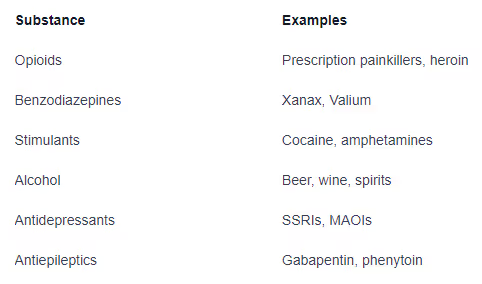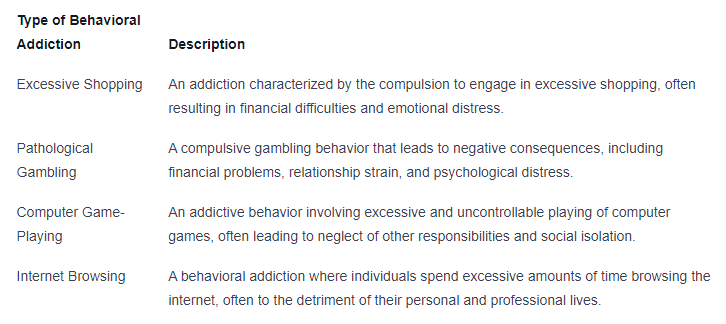Different Types of Addiction: Physical and Behavioral

Understanding Addiction
When examining the concept of addiction, it is essential to gain a comprehensive understanding of what it entails and the different types that exist.
What is Addiction?
Addiction refers to a complex condition characterized by the inability to control or stop engaging in a particular behavior or substance use, despite negative consequences. It is often associated with a compulsive desire to seek out and continue the behavior or substance, leading to a loss of control and interference with daily life.
Physical Addiction vs. Behavioral Addiction
Addiction can manifest in various ways, and two primary categories are physical addiction and behavioral addiction.
Physical addiction, also known as substance addiction, occurs when the body develops a dependence on a specific substance. This dependence often leads to withdrawal symptoms when the substance is no longer consumed. Physical addiction is commonly associated with substances such as drugs and alcohol, where tolerance, withdrawal symptoms, and physical cravings are experienced. Examples of physical addiction include opioid or alcohol addiction [3].
On the other hand, behavioral addiction revolves around compulsive behaviors rather than substances. Individuals with behavioral addictions exhibit addictive behaviors towards activities such as gambling, shopping, internet use, or eating. These addictions involve psychological dependence and a lack of control over the behavior [2]. Examples of behavioral addiction include gambling, shopping, or gaming addictions.
While physical addiction involves changes in the brain's chemistry and functioning due to substance use, behavioral addiction affects the brain's reward system and is associated with seeking rewards and pleasure from certain behaviors.
It's important to note that addiction, whether physical or behavioral, can have severe consequences on an individual's health, relationships, work, and overall well-being. Effective treatment approaches should address both the physical and psychological aspects of addiction to support long-term recovery [2].
Physical Addiction
Physical addiction is a type of addiction that involves a dependence on a specific substance. It occurs when the body develops a physical reliance on a substance and experiences withdrawal symptoms when the substance is no longer consumed. This type of addiction is often associated with drugs and alcohol, although it can occur with other substances as well.
Definition and Characteristics
Physical addiction is characterized by changes in the brain's chemistry and functioning due to substance use. With prolonged substance use, the body becomes accustomed to the presence of the substance and adapts to its effects. This leads to the development of tolerance, where larger amounts of the substance are needed to achieve the desired effect. Additionally, physical addiction involves physical cravings for the substance, as the body has become reliant on it to function normally.
Withdrawal Symptoms and Dependence
One of the defining features of physical addiction is the occurrence of withdrawal symptoms when the substance is abruptly discontinued. Withdrawal symptoms can vary depending on the substance involved but often include physical and psychological discomfort. Examples of withdrawal symptoms may include nausea, sweating, tremors, anxiety, insomnia, and intense cravings for the substance.
Physical addiction also involves the development of dependence on the substance. Dependence refers to the body's reliance on the substance to function properly. When someone is physically dependent on a substance, stopping its use can lead to withdrawal symptoms and an overwhelming urge to continue using the substance to alleviate these symptoms.
Common Examples of Physical Addiction
Physical addiction can develop with various substances, including drugs and alcohol. Some common examples of physical addiction include:

Physical addiction can also occur with the recreational misuse of substances such as alcohol, opioids, and benzodiazepines. It's important to note that physical addiction can have serious health consequences and may require professional treatment to overcome.
Understanding the nature of physical addiction is essential for recognizing the signs and seeking appropriate help. By addressing the physical aspects of addiction, individuals can work towards recovery and regain control over their lives.
Behavioral Addiction
Behavioral addiction, as described by the NCBI, is similar to drug addiction, but instead of being addicted to a substance, individuals become addicted to a particular behavior or the feeling associated with it. Unlike physical addiction, behavioral addiction does not involve physical signs of dependence on a substance.
Definition and Characteristics
Behavioral addiction, similar to substance-related addiction, can induce specific reward effects through biochemical processes in the body, leading to an addictive potential. Individuals with behavioral addiction may experience symptoms similar to those with alcohol and drug addiction, as well as other obsessive behaviors. They may develop addiction-specific phenomena, such as craving, excessive behavior, psychological and physical withdrawal symptoms, loss of control, development of tolerance, and perceiving psychotropic effects.
Psychological and psychiatric viewpoints on behavioral addiction suggest that individuals with this type of addiction may experience various disorders, including anxiety, depression, obsessive thoughts, withdrawal and isolationism, affective disorders, disturbances in social relationships, academic problems, occupational or interpersonal difficulties, and behavioral changes upon reduction or cessation of the addictive behavior.
Psychological Dependence and Compulsive Behaviors
Behavioral addiction involves psychological dependence on a specific behavior or activity. Individuals may feel a strong urge or compulsion to engage in the addictive behavior, often to the point of it becoming uncontrollable. This compulsive behavior can lead to negative consequences in various aspects of their lives, including relationships, work, and mental well-being.
Common Examples of Behavioral Addiction
Several behaviors have been recognized as potential sources of addiction. Some common examples of behavioral addiction include:

These examples highlight the diverse range of behaviors that can become addictive and have a significant impact on individuals' lives. It's important to recognize the signs of behavioral addiction and seek appropriate support and treatment when needed.
Understanding the characteristics and consequences of behavioral addiction can help individuals and their loved ones recognize the problem and take steps towards recovery and a healthier lifestyle.
The Impact of Addiction
Addiction, whether physical or behavioral, can have significant consequences on various aspects of an individual's life. Understanding these consequences is crucial for recognizing the importance of seeking appropriate treatment and support. In this section, we will explore the specific consequences of physical addiction and behavioral addiction, as well as the interconnectedness between different types of addiction.
Consequences of Physical Addiction
Physical addiction involves changes in the brain's chemistry and functioning due to substance use. As a result, individuals with physical addiction experience a strong physical dependence on the substance, leading to withdrawal symptoms when the substance is removed [3]. Some common consequences of physical addiction include:
- Intense cravings and compulsive drug-seeking behavior
- Physical withdrawal symptoms such as nausea, tremors, and sweating
- Tolerance, which requires larger amounts of the substance to achieve the desired effect
- Health complications and damage to organs due to substance abuse
- Impaired cognitive function and memory loss
- Social and relationship problems, including strained family dynamics and loss of friendships
Consequences of Behavioral Addiction
Behavioral addiction, in contrast to physical addiction, does not involve physical dependence on a substance. It is characterized by compulsive behaviors that provide temporary relief or pleasure, leading to negative consequences in an individual's life. Some common consequences of behavioral addiction include:
- Preoccupation with the addictive behavior, leading to neglect of responsibilities and personal relationships
- Loss of control over the behavior, with unsuccessful attempts to reduce or stop engaging in it
- Negative impact on mental health, including increased anxiety and depression
- Financial problems due to excessive spending on the addictive behavior
- Isolation and withdrawal from social activities and hobbies
- Decline in academic or work performance
Interconnectedness of Different Types of Addiction
While physical and behavioral addiction have distinct characteristics, it is important to acknowledge that they can coexist or even lead to one another. For example, individuals with physical addiction may develop behavioral addictions as they seek alternative sources of pleasure or relief. Moreover, certain behaviors, such as excessive gambling or compulsive eating, can trigger the release of neurotransmitters in the brain, leading to physical dependencies [2].
The interconnectedness of different types of addiction highlights the importance of comprehensive treatment approaches that address both the physical and psychological aspects of addiction. By targeting the underlying causes and triggers, individuals can work towards long-term recovery and improve their overall well-being.
Understanding the consequences of addiction, whether physical or behavioral, reinforces the need for timely intervention and support. If you or someone you know is struggling with addiction, it is essential to seek professional help and explore treatment options to regain control and lead a healthier, more fulfilling life.
Treatment Approaches for Addiction
When it comes to addressing addiction, it is important to consider the specific treatment approaches for different types of addiction. Physical addiction and behavioral addiction require tailored strategies to support individuals on their journey to recovery.
Physical Addiction Treatment
Physical addiction often involves changes in the brain's chemistry and functioning due to substance use. To address physical addiction, medical detoxification is often necessary to manage the withdrawal symptoms safely. Medication-assisted treatment may also be utilized to support the recovery process. This approach combines medications with counseling and behavioral therapies to address the physical dependence on substances [2].
During the physical addiction treatment, healthcare professionals closely monitor the individual's progress, manage withdrawal symptoms, and provide support to minimize relapse risks. The goal of physical addiction treatment is to help individuals detoxify their bodies from the addictive substance, reduce cravings, and manage any underlying medical conditions associated with the addiction.
Behavioral Addiction Treatment
Behavioral addiction, on the other hand, affects the brain's reward system and is characterized by seeking rewards and pleasure from certain behaviors. The treatment approach for behavioral addiction primarily focuses on psychological interventions. Cognitive-behavioral therapy (CBT) is commonly used to address the underlying thoughts, emotions, and behaviors associated with the addiction. Group therapy, support groups, and other forms of psychotherapy may also be beneficial in addressing behavioral addiction.
During behavioral addiction treatment, individuals learn coping mechanisms, develop healthier habits, and gain insight into the psychological factors contributing to their addiction. The therapy sessions aim to identify triggers and develop strategies to manage cravings and prevent relapse. By addressing the root causes of the addictive behaviors, individuals can work towards long-term recovery.
Addressing the Physical and Psychological Aspects of Addiction
It is important to recognize that both physical and behavioral addictions can have severe consequences on an individual's health, relationships, work, and overall quality of life. Effective treatment approaches should address both the physical and psychological aspects of addiction in order to support long-term recovery.
Integrated treatment approaches that combine medical interventions, therapy, and support systems are often recommended to address the interconnected nature of physical and behavioral addiction. This comprehensive approach ensures that individuals receive the necessary medical support to manage physical withdrawal symptoms, while also addressing the psychological aspects of addiction through therapy and behavioral modification techniques [3].
By addressing both the physical and psychological components of addiction, individuals can develop the necessary tools and strategies to overcome their addiction, achieve sustained recovery, and improve their overall well-being.
References
[1]: https://www.mayoclinic.org/diseases-conditions/drug-addiction/symptoms-causes/syc-20365112
[2]: https://fherehab.com/learning/difference-beahvioral-drug-addiction/
[3]: https://newchoicestc.com/blog/types-of-addiction/
